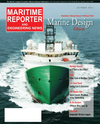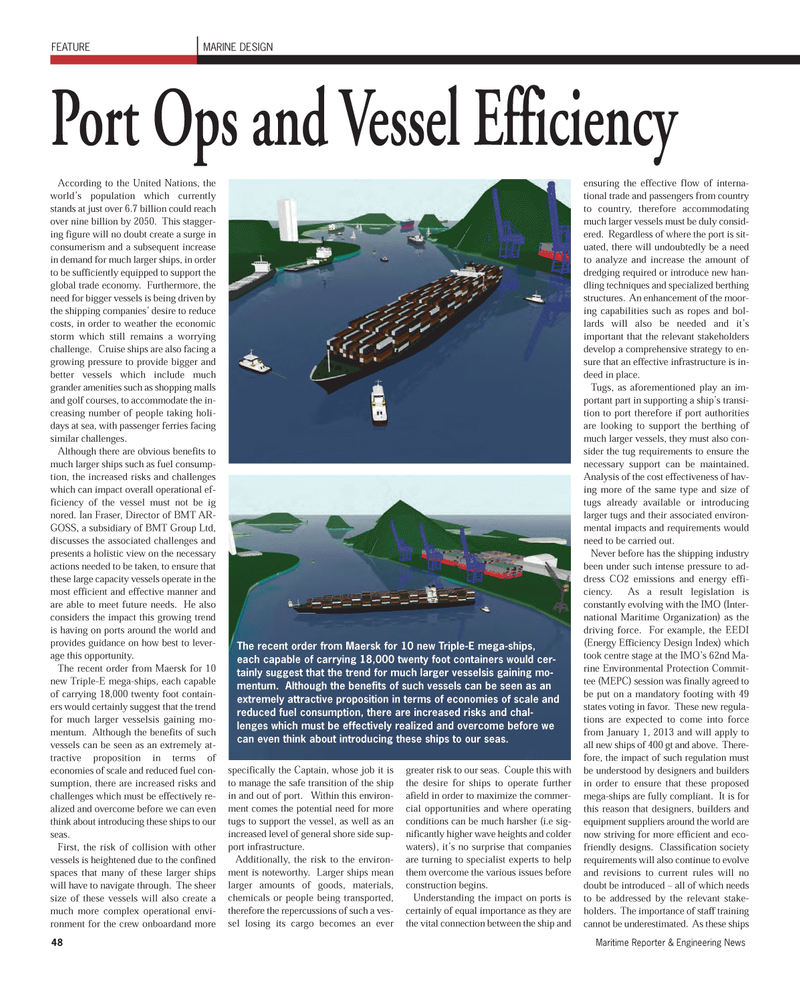
Page 48: of Maritime Reporter Magazine (October 2011)
Marine Design Annual
Read this page in Pdf, Flash or Html5 edition of October 2011 Maritime Reporter Magazine
According to the United Nations, theworld?s population which currently stands at just over 6.7 billion could reach over nine billion by 2050. This stagger- ing figure will no doubt create a surge in consumerism and a subsequent increasein demand for much larger ships, in order to be sufficiently equipped to support the global trade economy. Furthermore, the need for bigger vessels is being driven by the shipping companies? desire to reduce costs, in order to weather the economicstorm which still remains a worrying challenge. Cruise ships are also facing a growing pressure to provide bigger and better vessels which include much grander amenities such as shopping mallsand golf courses, to accommodate the in-creasing number of people taking holi-days at sea, with passenger ferries facing similar challenges. Although there are obvious benefits to much larger ships such as fuel consump- tion, the increased risks and challengeswhich can impact overall operational ef- ficiency of the vessel must not be ig nored. Ian Fraser, Director of BMT AR- GOSS, a subsidiary of BMT Group Ltd,discusses the associated challenges andpresents a holistic view on the necessary actions needed to be taken, to ensure that these large capacity vessels operate in the most efficient and effective manner and are able to meet future needs. He alsoconsiders the impact this growing trend is having on ports around the world and provides guidance on how best to lever- age this opportunity. The recent order from Maersk for 10new Triple-E mega-ships, each capable of carrying 18,000 twenty foot contain-ers would certainly suggest that the trend for much larger vesselsis gaining mo- mentum. Although the benefits of such vessels can be seen as an extremely at- tractive proposition in terms of economies of scale and reduced fuel con-sumption, there are increased risks andchallenges which must be effectively re- alized and overcome before we can even think about introducing these ships to ourseas. First, the risk of collision with othervessels is heightened due to the confined spaces that many of these larger ships will have to navigate through. The sheer size of these vessels will also create a much more complex operational envi- ronment for the crew onboardand more specifically the Captain, whose job it is to manage the safe transition of the shipin and out of port. Within this environ- ment comes the potential need for moretugs to support the vessel, as well as an increased level of general shore side sup- port infrastructure. Additionally, the risk to the environ- ment is noteworthy. Larger ships mean larger amounts of goods, materials, chemicals or people being transported,therefore the repercussions of such a ves- sel losing its cargo becomes an ever greater risk to our seas. Couple this withthe desire for ships to operate furtherafield in order to maximize the commer- cial opportunities and where operatingconditions can be much harsher (i.e sig-nificantly higher wave heights and colder waters), it?s no surprise that companies are turning to specialist experts to help them overcome the various issues before construction begins. Understanding the impact on ports iscertainly of equal importance as they are the vital connection between the ship andensuring the effective flow of interna- tional trade and passengers from countryto country, therefore accommodating much larger vessels must be duly consid- ered. Regardless of where the port is sit- uated, there will undoubtedly be a needto analyze and increase the amount ofdredging required or introduce new han- dling techniques and specialized berthingstructures. An enhancement of the moor- ing capabilities such as ropes and bol-lards will also be needed and it?s important that the relevant stakeholders develop a comprehensive strategy to en- sure that an effective infrastructure is in- deed in place.Tugs, as aforementioned play an im- portant part in supporting a ship?s transi- tion to port therefore if port authoritiesare looking to support the berthing ofmuch larger vessels, they must also con- sider the tug requirements to ensure thenecessary support can be maintained.Analysis of the cost effectiveness of hav- ing more of the same type and size oftugs already available or introducing larger tugs and their associated environ- mental impacts and requirements would need to be carried out. Never before has the shipping industry been under such intense pressure to ad-dress CO2 emissions and energy effi- ciency. As a result legislation is constantly evolving with the IMO (Inter- national Maritime Organization) as the driving force. For example, the EEDI (Energy Efficiency Design Index) which took centre stage at the IMO?s 62nd Ma- rine Environmental Protection Commit- tee (MEPC) session was finally agreed to be put on a mandatory footing with 49states voting in favor. These new regula- tions are expected to come into force from January 1, 2013 and will apply toall new ships of 400 gt and above. There- fore, the impact of such regulation must be understood by designers and builders in order to ensure that these proposedmega-ships are fully compliant. It is for this reason that designers, builders and equipment suppliers around the world are now striving for more efficient and eco- friendly designs. Classification society requirements will also continue to evolve and revisions to current rules will no doubt be introduced ? all of which needsto be addressed by the relevant stake- holders. The importance of staff training cannot be underestimated. As these ships 48Maritime Reporter & Engineering News Port Ops and Vessel Efficiency FEATURE MARINE DESIGNThe recent order from Maersk for 10 new Triple-E mega-ships, each capable of carrying 18,000 twenty foot containers would cer-tainly suggest that the trend for much larger vesselsis gaining mo- mentum. Although the benefits of such vessels can be seen as anextremely attractive proposition in terms of economies of scale and reduced fuel consumption, there are increased risks and chal- lenges which must be effectively realized and overcome before we can even think about introducing these ships to our seas. MR Oct.11 # 6 (42-49):MR Template 10/5/2011 1:03 PM Page 48

 47
47

 49
49
